Day 2 | On our way to Dalmatia
After waking up early in the morning we had a quick breakfast and got into the car. It was already close to 30 degrees outside and made the trip a bit difficult to endure.
It took us around 4 hours from Zagreb to get there as we stopped a few times to see the interesting things on our way there. I will enlist some of them along with the photographs.
Rastoke - a small hiden magical place behind the road
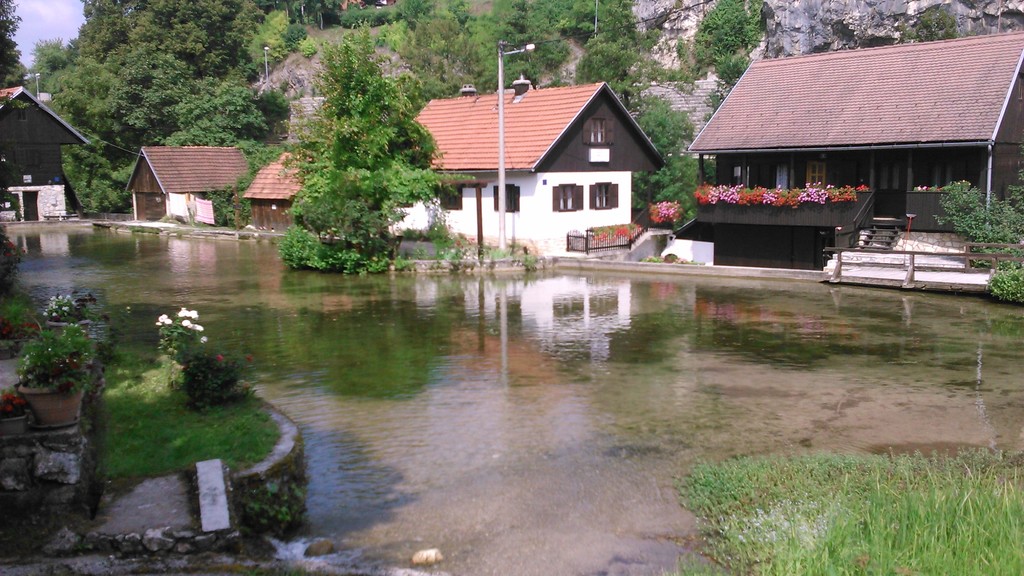
One of them was the little oasis surrounded by the hills of Gorski Kotar and close to the infamous National Park 'Plitvice lakes'. It is called Rastoke and it's right next to the town of Slunj. It might be about 100 km away from the capital and to access it you can use the D1 road Karlovac-Plitvice lakes. It seems to be isolated and not-known by many people (which is also great) but those who know where it is will highly likely stop to take a break, drink coffee or eat something. Rastoke will probably associate you of some magical place as there you can see practically nothing related to the modern houses and streets. But rather old traditional wooden houses with flowers, lake and fish ponds, everythign surrounded by the forest and many waterfalls. As the name in Croatian means and suggests a 'place where something flows into something else'. In this case it is about the water - the river Slunjčica will end up in bigger river Korana. And the locals used the power of the river to help them in daily lives. Thus you can find there several mills that are still rotating thanks to the water. You can even go over an old bridge (including cars) on the other side and enjoy the view on the cliff with houses on it, vegetation and waterfalls. If you have more time or are a curious person, you can continue further walking down the bridge along the river bank. There might still be a wooden dock which looks pretty cool and like from the movies.
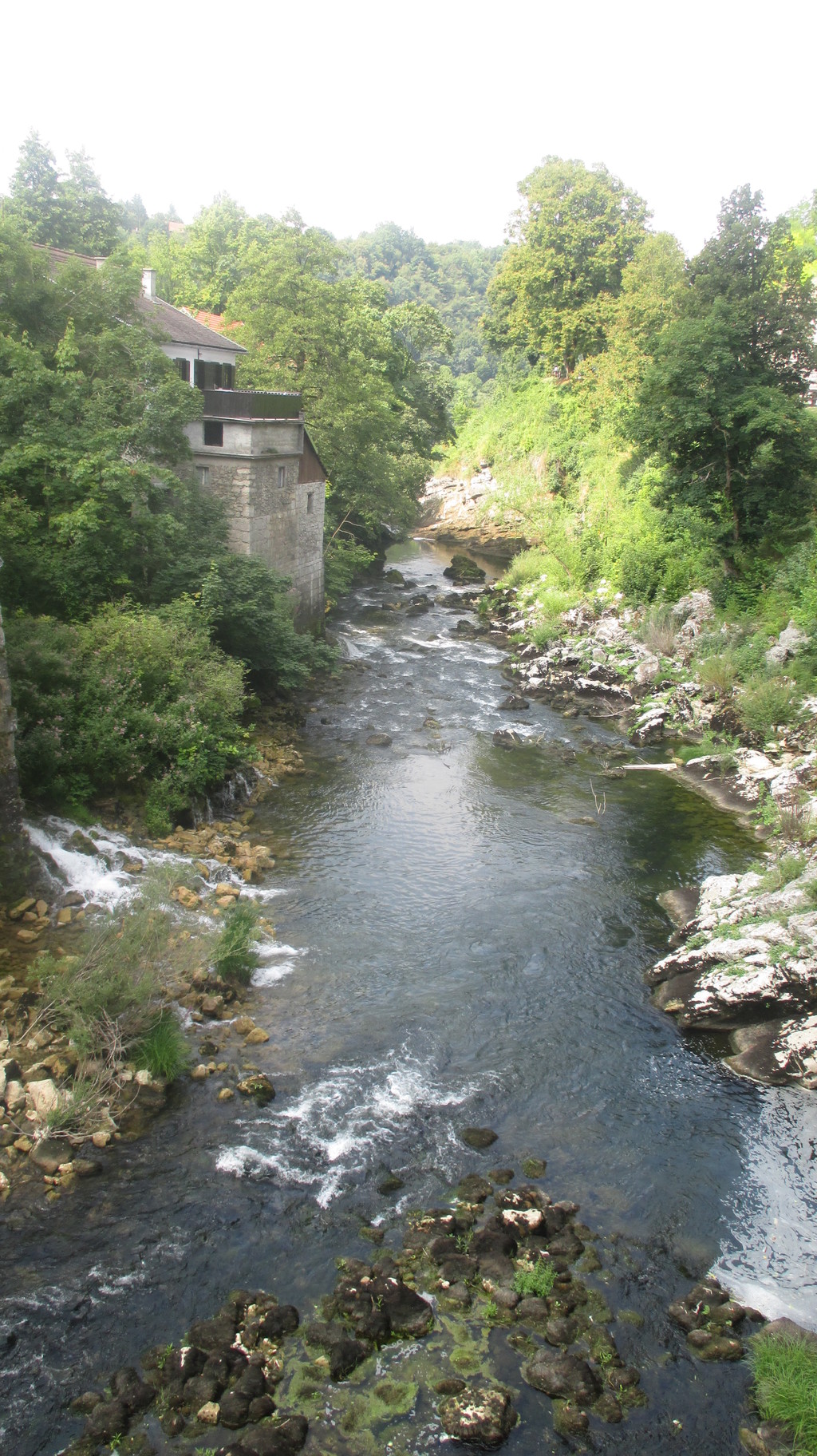
All in all, taking a break at Rastoke is always a good decision every time we go to the coast or back to Zagreb. It is not only a splendig, amazing experience for the foreigners but also for the locals. It will make you forget about the hasty and loud reality and everyday from the big cities and places (and I found out a date that it's being inhabited by around 60 people, so it truly is amazing), but calm you down and let you enjoy the nature fully. I recommend you to take a way around the place, it shouldn't last more than 10 minutes. You have a restaurant and café there if you have more time. Also can check the traditional mills made from wood and stone.
Alright, after a break and taking tons of photographs to show later in Japan we went back into the car and headed south to the coast.
The mountains and valleys
I have not described the landscape and the area from around Zagreb till Rastoke as you have noticed. Honestly and to me personally it is a bit boring. It's mostly a big plain with uninteresting landscape. However, it is just the part between Zagreb and the south. To the west and behind Zagreb the hills start again. Towards the east actually you can see the beginning of the huge plan that is in geography called The Great Panonnian Plain and it is an area that covers most of the region called Slavonia (with several "islands" of hills), northern Serbia (Vojvodina), Hungary and parts of other neighbour countries. I find it a big boring maybe, everything is flat. And I'm lucky that Zagreb is just there where the Great Panonnian Plain collides with the Alps and hills in the west. Thus is also Croatia I could say around half plain and the other part is more mountain-like since the eastern branches of the Alps (From Switzerland, Austria and Slovenia) go all along the coast (we call the mountains Dinarides, one part is Velebit and another Dinara with the highest peak and point of Croatia) south-east to Montenegro, Albania and then further into the Greek mountains. All this mountain range is connected from Switzerland till Greece. Sounds cool, right?
Anyway, we are now going to enter this mountain range. It is called Lika & Gorski Kotar. This might associate some of the travelers of Austria and Slovenia. And not without a reason since it's the same type of landscape (maybe just not that high any more) you can find there. While driving close to Plitvice lakes we enjoyed the green forests and the smell of it, the shadows over the road and the sound of the river and the water falls. When passing by the entrance to Plitvice lakes you can see at least 200 people waiting in the waiting line. Unfortunately, I think they are mostly foreigners as going alone or with a family to Plitvice is nowaday for an average Croatian family too much. We do the excursions in groups, with school or somehow... even I have never been there, only saw a glimpse of it from above...
Relatively close to Plitvice and a bit more to the south is the camp Borje. It is a popular destination for many to stop at for lunch, coffee, toilet or just to take a walk with their pet. That is what we do. It is situated again at the edge of the plain surrounded by the mountains (Dinaridi). There you can find a huge restaurant and also a small playground for children. The parking lot has lots of spaces for the cars and the trees so you can park beneath the shadows. Next to the building there is a huge yard surrounded by a wooden fence (but you can go under it or jump above it). We usually use it to take our dog for a walk or run.
Now comes a part where I would like to add my comment and compare it with Japan. So, after the vast forests and green areas that are like heaven during hot days in summer we went through several tunnels now already driving through the hills, but still with lots of green area. Then after maybe 30 minutes or so, when being maybe almost at the half of our way to our destination, we left this kind of a landscape behind us and entered kind of valleys. So now you have from both sides little hills but mostly plains, however a few kilometers away there are big hills and mountains. If you want I could say it looks a bit like Rohan with the hills behind the golden plains. Same here. Some parts are green and some pretty yellow, but still with forests under the mountains. But I mentioned Japan, did not I?
Yes, so in Japan all the valleys are turned quickly into the towns or cities. I don't remember any valley there that hasn't been turned into a huge plantage or inhabited. Here it is not the case. There are houses or some villages but not that many you could notice them. It's mostly pure nature. Every here and there you can come across some restaurant or hostel along the road. It is nice when you can see decorated houses built from wood with lots of flowers around them - the signs that people care about it. But there are again some ugly ones that you just do not want to see. Anyway, for my Japanese guest it was a bit surprising to see almsot uninhabited plain and the area. This county is btw the least populated of all regions in Croatia which also represents kind of a problem with demographics, many moved out, many died and mostly the elderly decided to stay as they have no more options outside their homes from childhood. In the past throught the last few centuries this area was also part of the Military Frontier (Croatian within the Habsburg Monarchie) and was inhabited by the soldiers and rangers to protects the land and the borders of the Empire/Kingdom/Union from the Ottoman attacks and raids. Under this beautiful landscape lie bones of hundreds of thousands of soldiers who died in the past centuries. There was also one part when the road goes between the center of the really huge valley (Krbavsko polje) and the hills where the crucial battle between the medieval Croatian Kingdom and the Ottoman Empire took place in 1493 where the Croats have been heavily defeated and changed the shape of borders and mentality that have remained until today.
This valley is interesting as it can be at some specific time during other seasons when it rains a lot completely under the water. So then you have a huge lake surrounded by the mountains and the depth can go as far as 2 meters. It is hard to believe while watching the golden plain with trees that few months earlier it had been completely under the water. So if you are going to the coast with your Erasmus group from Zagreb or Rijeka, don't use the highway (which is more expensive, okay faster but still you cannot see everything I enlisted) but rather this local road.
After an hour maybe of going through this landscape we ended up in the hills again and the road goes just like a snake. Again many tunnels, still green forests around... until we pass one relatively short tunnel and things change.
Dalmatia - 'Gondorian' landscape & Mediterranean climate
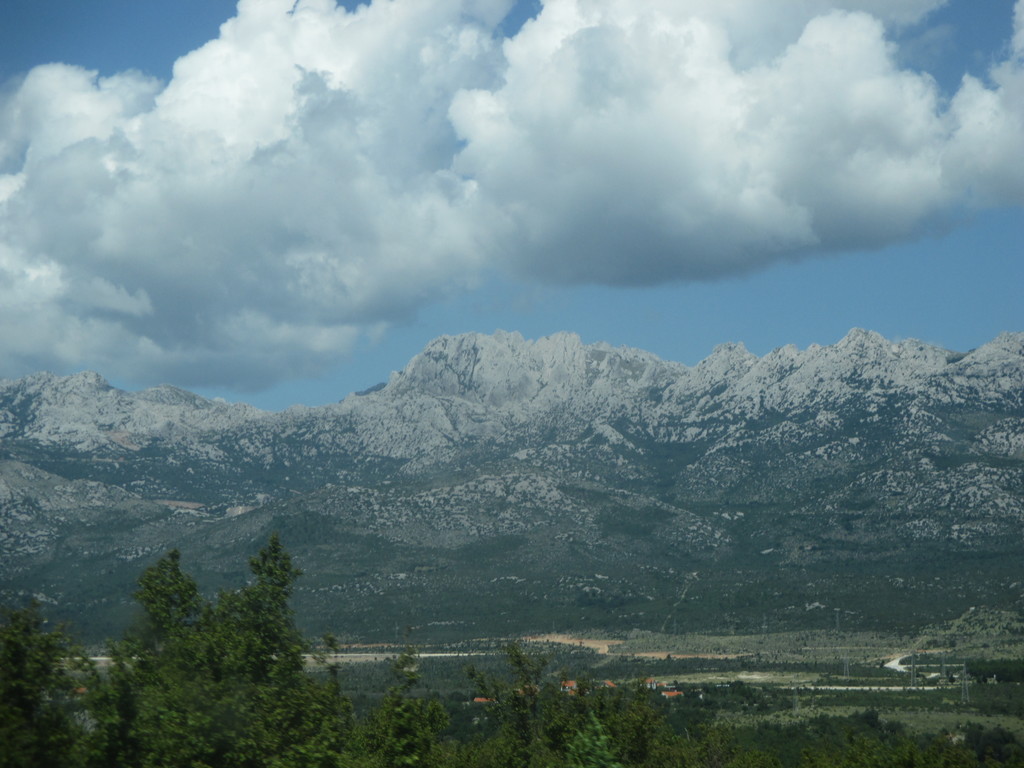
So... after passing the tunnel we notice sudden change in the landscape. We are still int he mountains but no more green forests, no more alpine pine trees. What happened?
Firstly, we call this 'an unofficial tunnel' to Dalmatia. So I would say we entered Dalmatia now. You can see more stones now - the limestone. And also how the rivers and waters modelated thet surfaces of the rocks and cliffs around. It all looks grayish and white. The vegetation also changed so there are more bushes. Now the complete imagine would be having white limestone with lots of low kind of trees, not many forests and lots of bushes. This area is also known to have numerous caves (and one of them, 'Lukina jama' or 'Luka's cave' is around 1 400m deep and is 14th deepest cave in the world! ). We are now driving on and through the mountain of Velebit.

This area precisely may not be inhabited that much since the coast is relatively close (yet we cannot see the sea right now) so people naturally are eager to settle closer to the big water. The another reason and fun fact is that in the mountains the strong wind bura can be blowing. Not rarely are the roads and bridges closed when bura arrives from the North-Eastern direction, coming down the mountains and you should better run into the house and close the windows.
But what you can enjoy is that the road goes from the greater heights on the mountains slowly down the hill into the valleys. You see, the mountains here (Velebit technically) stand as walls and divide the continental part of Croatia with the coastal one. And it is difficult to live during winter or summer in the valleys or beneath the mountains since it can be very cold in the winter or just too hot in summer. However, there are many accumulation snakes on the tops of the mountain (and we are going to go and take photos for Japan later next to one tube). Nevertheless, we started our journey now with totally different landscape and view from the one 1-2 hours ago. The green plains from Zagreb and the forests and hills of Gorski Kotar are have been replaced by golden-white scene of the Northern Dalmatia.
We stopped close to one tube in order to take some cool photographs. Our Japanese guest in the end felt tired and slept during the most interesting part of our journey and missed the view. But now was about time to make a pause. We stopped by this tube which goes few kilometeres into the valley and there is another lake used by the local population for power and maybe fresh water at home.
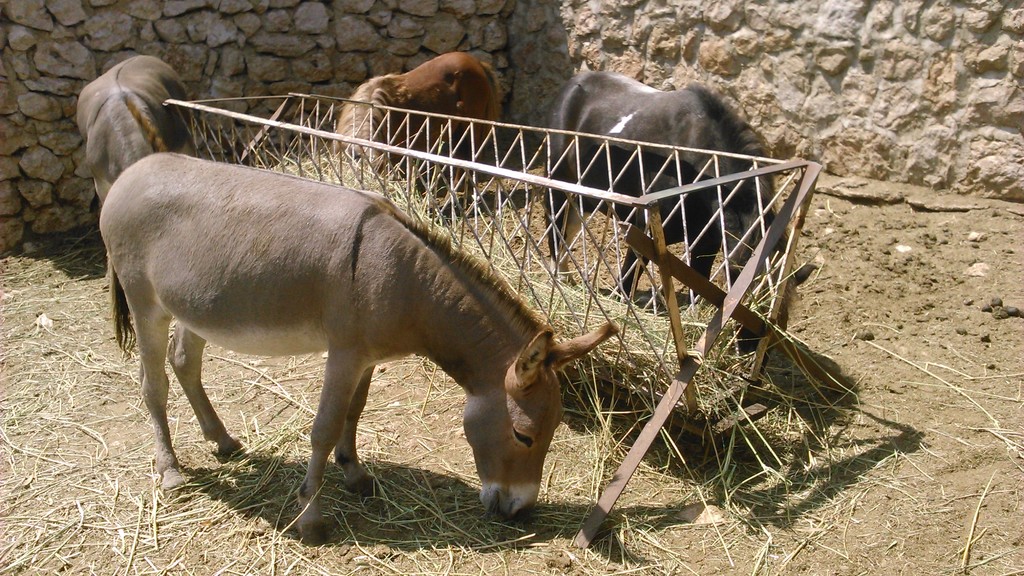
The next stop was pretty spontanous as we headed to the canyon or river Zrmanja (Zarmanya) but stopped by the private ZOO of some restaurant owners. Now this ZOO is controversial as it is a home to several exotic animals not originally from Croatia or this part of Europe because they live in a very small life area. I do not want to promote this as a good thing since the owners have been critized many times yet due to political connections apparently nothing was done to precent this and allow the animals better life conditions and ensure they are treated properly.
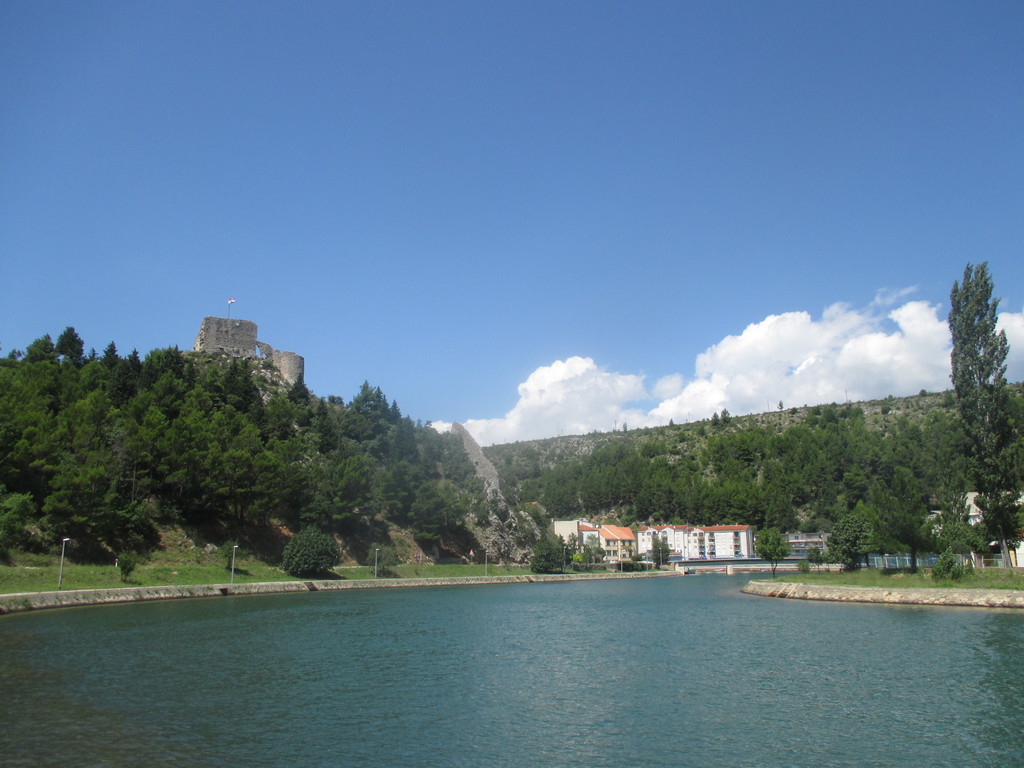
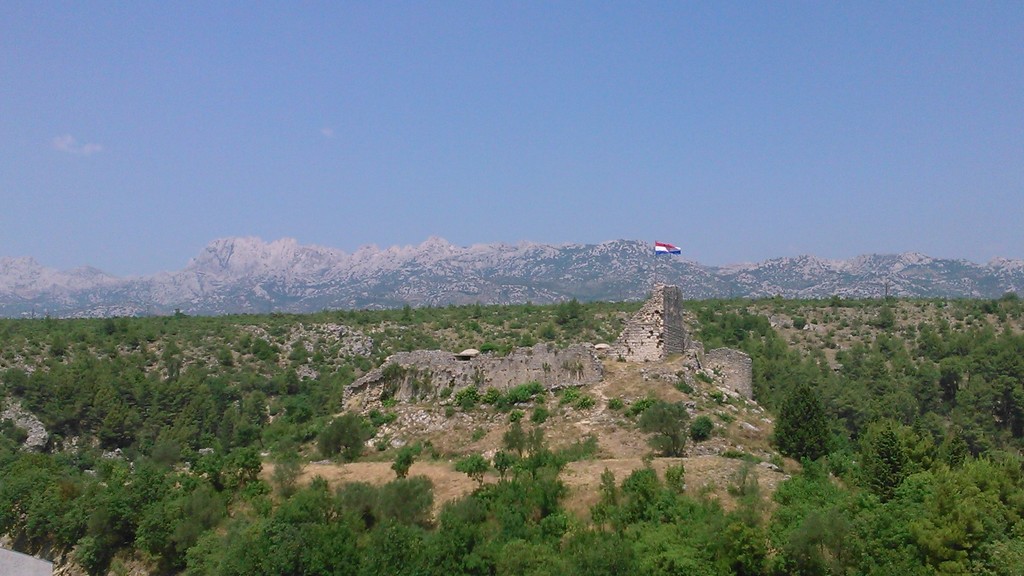
We saw the symbol of Dalmatia - the donkey (továr), a monkey, a Guinean pig, some parrots and the others. After making a small tour and taking photos of them (and you'll see how much space they have) we jumped back now in the hot car (it must have been above 30 degrees and around noon) and wanted to hurry up to our destination.
Back in the valley and reaching Vodice
After the tube and the ZOO the road was going downhill towards the little town of Obrovac and the canyon of river Zrmanja. Zrmanja's spring is probably in the mountains or somewhere in the valley and it might also look like the part with the Argonaths from the Fellowship of the Ring (if you just add them). The river is popular for rafting and canoeing. Unfortunately haven't tried it personally there but we see many tourits or sport lovers doing it. The town of Obrovac is not going to impress you and rather watch the river and cliffs but when the road on the other side of the bridge and river bank goes up and again like a snake, we are climbing a bit, you can see one hill in the middle of the canyon with a fortress from the medieval ages and far away now the white mountains - Velebit. Once we get again on the top of the hill you have for the first time the view over Velebit mountain range that stretches far to the north. And it looks Gondorian. White moutnains and the golden valleys. There is only the White City missing. But we do not have money for that...
It took us now maybe an hour or less to reach Vodice. We also soon had the opportunity to see the sea and a small gulf. The rest of the trip now was not something special and worthy of mentioning. I think I also fell asleep for a bit. Madoka was for sure (again). But then we saw the familiar hill 'Okit' and the church on the top, the sign 'Vodice' and then it was just several minutes before we entered the town.
Then the sound of the crickets which means that we really are there (you cannot hear them in the continental part), many people walking in the swimming suit and towels around, lots of motorbike.. within minutes we reached our street, the parking lot was waiting for us and time to see the familiar faces. Madoka woke up.
Photo gallery
Content available in other languages
- Español: Día 2 | De camino a Dalmacia
- Italiano: Giorno 2: in viaggio verso la Dalmazia
Want to have your own Erasmus blog?
If you are experiencing living abroad, you're an avid traveller or want to promote the city where you live... create your own blog and share your adventures!
I want to create my Erasmus blog! →










Comments (0 comments)